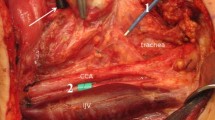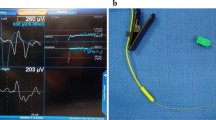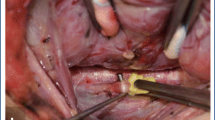Abstract
Background
Intra-operative nerve monitoring (IONM) of the recurrent laryngeal nerve (RLN) during thyroid and parathyroid surgery is thought to aid in identification and dissection of the RLN. While utilization of IONM is increasing, one area of variability in its application is the assessment of adequate endotracheal tube electrode placement for IONM during the case. The main objective of this study is to assess the overall success of utilizing respiratory variation to confirm proper endotracheal tube placement for RLN monitoring.
Methods
A prospective study of RLN monitoring during thyroid and parathyroid surgery at an academic referral center.
Results
Fifty-five cases were included. Fifty (91 %) achieved optimal respiratory variation during endotracheal tube position. Five (9 %) required repeat laryngoscopy to confirm correct endotracheal tube placement following patient positioning. For the respiratory variation group, average amplitude achieved during initial vagus, maximum vagus, initial RLN, and maximal RLN was 700 (±474) mA, 921 (±616) mA, 887 (±584) mA, and 1330 (±843) mA during evoked stimulation, respectively. For the repeat laryngoscopy group, average amplitude achieved during initial vagus, maximum vagus, initial RLN, and maximal RLN evoked stimulation was 591 (±364) mA, 959 (±306) mA, 771 (±424) mA, and 1462 (±855) mA during evoked stimulation, respectively. There was no statistical difference between the two groups for average initial vagus amplitude (p = 0.62), average maximum vagus amplitude (p = 0.89), average initial RLN amplitude (p = 0.67), or average maximum RLN amplitude (p = 0.74).
Conclusion
The findings of this study support the International Neural Monitoring Study Group recommendation that confirmation of endotracheal tube electrode placement be performed either by confirmation of adequate respiratory variation or by repeat direct laryngoscopy.




Similar content being viewed by others
References
Randolph GW, Dralle H, Abdullah H et al (2011) Electrophysiologic recurrent laryngeal nerve monitoring during thyroid and parathyroid surgery: international standards guideline statement. Laryngoscope 121(Suppl 1):S1–S16
Dralle H, Sekulla C, Lorenz K et al (2008) Intraoperative monitoring of the recurrent laryngeal nerve in thyroid surgery. World J Surg 32:1358–1366. doi:10.1007/s00268-008-9483-2
Snyder SK, Lairmore TC, Hendricks JC et al (2008) Elucidating mechanisms of recurrent laryngeal nerve injury during thyroidectomy and parathyroidectomy. J Am Coll Surg 206:123–130
Chiang FY, Lee KW, Chen HC et al (2010) Standardization of intraoperative neuromonitoring of recurrent laryngeal nerve in thyroid operation. World J Surg 34:223–229. doi:10.1007/s00268-009-0316-8
Horne SK, Gal TJ, Brennan JA (2007) Prevalence and patterns of intraoperative nerve monitoring for thyroidectomy. Otolaryngol Head Neck Surg 136:952–956
Sturgeon C, Sturgeon T, Angelos P (2009) Neuromonitoring in thyroid surgery: attitudes, usage patterns, and predictors of use among endocrine surgeons. World J Surg 33:417–425. doi:10.1007/s00268-008-9724-4
Singer MC, Rosenfeld RM, Sundaram K (2012) Laryngeal nerve monitoring: current utilization among head and neck surgeons. Otolaryngol Head Neck Surg 146:895–899
Ho Y, Carr MM, Goldenberg D (2013) Trends in intraoperative neural monitoring for thyroid and parathyroid surgery amongst otolaryngologists and general surgeons. Eur Arch Otorhinolaryngol 270:2525–2530
Dralle H, Sekulla C, Haerting J et al (2004) Risk factors of paralysis and functional outcome after recurrent laryngeal nerve monitoring in thyroid surgery. Surgery 136:1310–1322
Echeverri A, Flexon PB (1998) Electrophysiologic nerve stimulation for identifying the recurrent laryngeal nerve in thyroid surgery: review of 70 consecutive thyroid surgeries. Am Surg 64:328–333
Eltzschig HK, Posner M, Moore FD Jr (2002) The use of readily available equipment in a simple method for intraoperative monitoring of recurrent laryngeal nerve function during thyroid surgery: initial experience with more than 300 cases. Arch Surg 137:452–456 discussion 456–457
Snyder SK, Hendricks JC (2005) Intraoperative neurophysiology testing of the recurrent laryngeal nerve: plaudits and pitfalls. Surgery 138:1183–1191 discussion 1191–1182
Shindo M, Chheda NN (2007) Incidence of vocal cord paralysis with and without recurrent laryngeal nerve monitoring during thyroidectomy. Arch Otolaryngol Head Neck Surg 133(481–48):5
Hermann M, Hellebart C, Freissmuth M (2004) Neuromonitoring in thyroid surgery: prospective evaluation of intraoperative electrophysiological responses for the prediction of recurrent laryngeal nerve injury. Ann Surg 240:9–17
Beldi G, Kinsbergen T, Schlumpf R (2004) Evaluation of intraoperative recurrent nerve monitoring in thyroid surgery. World J Surg 28:589–591. doi:10.1007/s00268-004-7226-6
Lu IC, Chu KS, Tsai CJ et al (2008) Optimal depth of NIM EMG endotracheal tube for intraoperative neuromonitoring of the recurrent laryngeal nerve during thyroidectomy. World J Surg 32:1935–1939. doi:10.1007/s00268-008-9549-1
Dionigi G, Bacuzzi A, Boni L et al (2008) What is the learning curve for intraoperative neuromonitoring in thyroid surgery? Int J Surg 6(Suppl 1):S7–S12
Macias AES, O’Neil E, Kamani D, Malikin I, Konowitz P, Randolph GW (2014) Intraoperative electrophysiologic monitoring of the recurrent laryngeal nerve during thyroid and parathyroid surgery : The Massachusetts Eye and Ear Infirmary Monitoring Protocol with Collaborative Experience in over 3000 cases. Br J Anesth (submitted)
Barczyński M, Randolph GW, Cernea CR et al (2013) External branch of the superior laryngeal nerve monitoring during thyroid and parathyroid surgery: international neural monitoring study group standards guideline statement. Laryngoscope 123:S1-S14
Duclos A, Lifante JC, Ducarroz S et al (2011) Influence of intraoperative neuromonitoring on surgeons’ technique during thyroidectomy. World J Surg 35:773–778. doi:10.1007/s00268-011-0963-4
Dralle H et al (2004) What benefits does neural monitoring bring to thyroid surgery? Artz Krankenh 12:369–376
Deiner S (2010) Highlights of anesthetic considerations for intraoperative neuromonitoring. Semin Cardiothorac Vasc Anesth 14:51–53
Acknowledgments
This work was funded by the John and Claire Bertucci Thyroid Research fund.
Conflict of interest
None.
Author information
Authors and Affiliations
Corresponding author
Rights and permissions
About this article
Cite this article
Chambers, K.J., Pearse, A., Coveney, J. et al. Respiratory Variation Predicts Optimal Endotracheal Tube Placement for Intra-operative Nerve Monitoring in Thyroid and Parathyroid Surgery. World J Surg 39, 393–399 (2015). https://doi.org/10.1007/s00268-014-2820-8
Published:
Issue Date:
DOI: https://doi.org/10.1007/s00268-014-2820-8




